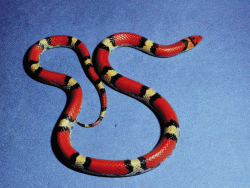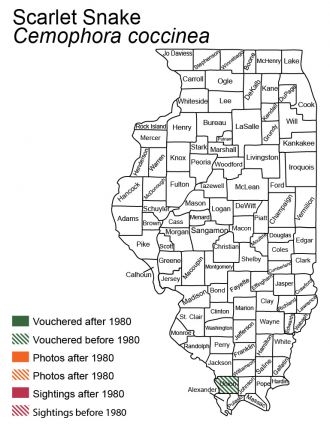Cemophora coccinea (Blumenbach, 1788)

Key Characters: Projecting rounded snout; smooth back scales; anal plate not divided.
Similar Species: Milksnake. See the Key to Snakes of Illinois for help with identification.
Subspecies: Three subspecies are recognized; Florida Scarletsnake, C. c. coccinea (Blumenbach, 1788), Northern Scarletsnake, C. c. copei Jan, 1863, and Texas Scarletsnake, C. c. lineri Williams, Brown & Wilson, 1966. Only the Northern Scarletsnake is known from Illinois.
Description: Small (up to 60 cm TL), slender, brightly banded snake. Back is white, cream, or yellow with large black-bordered red blotches. Head red, with dark crossbar near eyes, and barely broader than neck. Rostral scale enlarged and projects beyond lower jaw. Belly clear white or cream.
Habitat: Mixed woodlands on rocky, sandy soils.
Natural History: Semifossorial snake that spends most daylight hours buried in sand or under leaf litter, rotten logs, rocks, and other cover. In other states, eggs have been found buried in sand and pine needles late June through August. The 2-9 eggs per clutch probably hatch in September. Hatchlings range from 13 to 18 cm TL. Eats reptile eggs, insects, frogs, lizards, snakes, and mice. Main predators are other snakes, birds, and mammals.

Distribution Notes: Known in Illinois from one specimen collected in 1942 by Fred R. Cagle at Wolf Lake Swamp, Union County, and originally identified as a Red Milksnake. The specimen subsequently was correctly identified by Philip W. Smith, noted herpetologist at the Illinois Natural History Survey. Searches in the vicinity of Wolf Lake and nearby Pine Hills have yielded no additional specimens.
Status: Not listed as endangered because existence in Illinois remains uncertain despite isolated records from Indiana and Missouri.
Etymology: Cemophora – kemos (Greek) meaning muzzle; phoreus (Greek) meaning bearer, carrier; coccinea – coccineus (Latin) meaning ‘red like a berry’, scarlet. For the Northern Scarletsnake: copei – a patronym for Edward Drinker Cope (1840-1897).
Original Description: Blumenbach, J.F. 1788. Beytrag zur Naturgeschichte der Schlangen. Magazin f. d. Neuste Aug d. Physi u. Naturg. 5:1-13. For the Northern Scarletsnake: Jan, G. 1863. Enumerazione sistematica degli ofidi appartenenti al gruppo Coronellidae. Arch. Zool. Anat. Fisiol. 2 (2): 213-330 [1862].
Type Specimen: Not designated. For the Northern Scarletsnake: Museum d’Histoire naturelle de Geneve 524.74
Type Locality: “Florida”. For the Northern Scarletsnake: “Etats-Unis, Tennessee”
Original Name: Coluber coccineus Blumenbach, 1788:11. For the Northern Scarletsnake: Cemophora copei Jan, 1863:231
Nomenclatural History: The Scarletsnake has a complicated nomenclatural history. It was originally thought that Linnaeus’ Cemophora doliatus referred to Lampropeltis triangulum, but later evidence revealed it was actually based on Cemophora coccinea. For a while after this discovery some workers, including Phil Smith (1961), used the combination Cemophora doliatus to refer to the Scarletsnake until that name was suppressed under the rule of stability.

